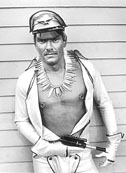|

Comment
on this story
What:
Into My Eyes, photography by Thomas Daniel
Where:
UT's Ewing Gallery, 1715 Volunteer Boulevard
When:
Through Aug. 31 (call 974-3200 for information). Artist's slide talk and reception this Monday, Aug. 27, at 7 p.m., in room 109 of the Art and Architecture Building.
|
|

UT's retrospective of Thomas Daniel's photography knocks our socks off
by Heather Joyner
In an essay on the images of Thomas Daniel (titled "A Matter of Pride"), critic John Yau wrote, "In taking his first photographs in Vietnam, Daniel gained lasting insights into the power relationship between photographer and subject. Rather than manipulating his subjects into a particular pose or exploiting them by theatricalizing their presentation, he chooses to function almost like a combat photographer."
Yau could have dropped the "almost" and said, "like the combat photographer he was"—for Daniel initially defined himself through images he created at 19—not old enough to walk into a bar on today's Cumberland Avenue and buy a beer. Those early photographs (dating as far back as 1967) have not lost their potency as documents of a war that killed approximately 58,000 Americans and more than two million Vietnamese. They still evoke what Pulitzer Prize-winning photojournalist Horst Faas has described as "the eerily seductive proximity of beauty and horror." And they mark the beginnings of a career that continues to be both courageous and artful. The search reflected in 80 black-and-white prints curated by Yau and Ted Potter (of Virginia Commonwealth University's Anderson Gallery) and on view at the Ewing Gallery is as fascinating as it is noble. If you see only one photography exhibit this year, make this the one.
Daniel himself might object to the term "search." Fond of saying that images find him, he remarked in a recent interview, "I don't set out, I wind up." His emphasis on remaining open to whatever moments of truth present themselves, combined with his talent for capturing those moments, is what sets him apart. He knows that forcing a situation distorts or destroys it. Yet any photojournalist—particularly in wartime—must be searching to connect his or her perception with "reality" in order to make sense of things. Why else have so many been willing to risk their lives in order to communicate their perceptions?
Along with Tim Page, the aforementioned Faas has assembled a book and exhibit including images by 135 deceased or missing photojournalists titled Requiem: By The Photographers Who Died In Vietnam And Indochina. Fortunately for us, Daniel survived three tours in the war and has since produced works informed by his experience. Beyond strengthening his ability to confront individuals directly and with a sense of immediacy, it's an experience that has inspired Daniel to speak for those who might instead be overlooked, misunderstood, or silenced—like people being baptized in a Virginia lake, androgynous prostitutes, or aged "Real Daughters of the Confederacy." Photographs of tent revivals and circus performers may now seem cliché, but Daniel explored such subject matter decades ago. And he brings to his most recent portraits of German World War II veterans and Dineh Indians (called Navajo) an equal measure of tolerance and respect. Daniel balances what he chooses to see with what demands to be seen.
One of the 1979 baptism shots from Amelia County shows a woman's head, nose held, as it is lowered into water by her preacher. Hovering above her, he is like a lover lost in an intimate act made all the more surreal by onlookers crowding the shore. Another image centers on the intense stare of a drenched young girl being held by her father. A woman stands nearby, arms demurely folded, gazing into the space of religious ecstasy. Unlike the woman and her father, the girl acknowledges Daniel's presence and projects mistrust combined with an awareness of her social destiny.
Yau has referred to the baptism series as marking a turning point in Daniel's development, and he sees in the portrait of Denver prostitute "Miss Trudy" a further leap. Like Diane Arbus, Daniel has managed to be both objective and compassionate. Yau has called it "a non-hierarchical relationship" in which Daniel's subjects "are sure that he is neither being a voyeur nor trying to pigeonhole them—however we might think of them, they make no attempt to elicit our sympathy."
Born in North Carolina and now residing in Richmond, Va., Daniel has become what the Ewing Gallery refers to as "an underground legend" whose photographs have "soul." The video accompanying his show presents him as the mellowed version of a rebellious 10th-grade drop-out—someone forced to choose the Army over jail after he was caught stealing. The exhibit itself is fairly traditional, but Daniel's images admit us into a place we'd not otherwise have access to. Ex-Nazis named Friedrich, Heinrich, and Erich, alongside aged daughters of Confederate soldiers and a Yoruba-sacrificed decapitated goat, are on the same losing side as Daniel's "freaks," although for different reasons. On the other hand, county beauty queens shine, almost squeaking with the advantages physical attractiveness affords them. His is a body of work that never fails to ring true. As sensational as Daniel's subjects are to begin with, our taking them in would be no different than rubbernecking an automobile accident if he didn't transcend appearances by allowing people to reveal themselves.
In an interview with D.C.-based journalist Chris Gilbert, Daniel described having seen a tear trickling from a dead soldier's eye. It was a sight he'd never forget—one that left him motivated to question what happens during moments of transition from life to death or (as Daniel added) from "life to life." He produced no photograph of that particular moment, but he has honored it ever since. We are privileged to share in his view of the world.

August 23, 2001 * Vol. 11, No. 34
© 2001 Metro Pulse
|